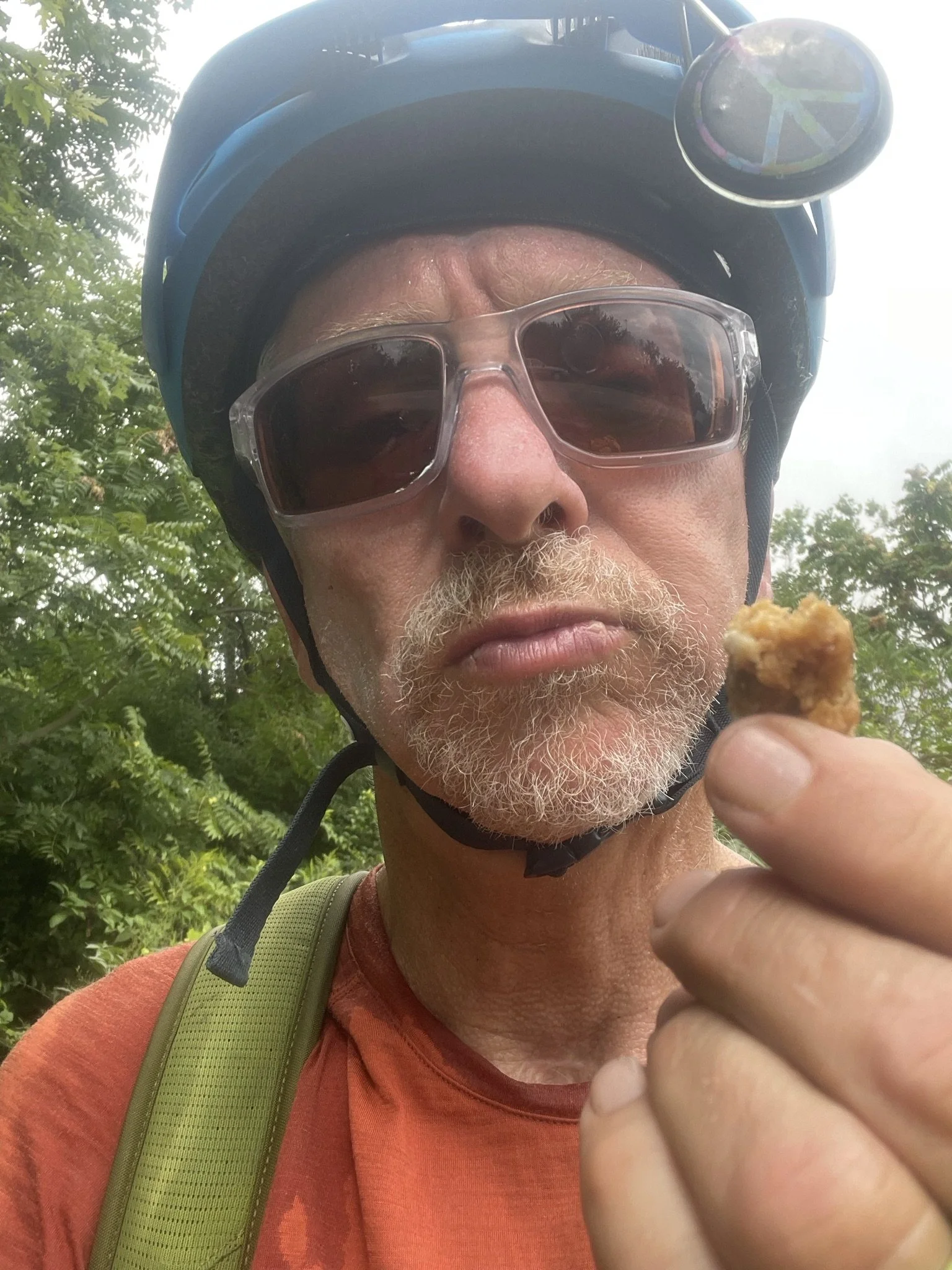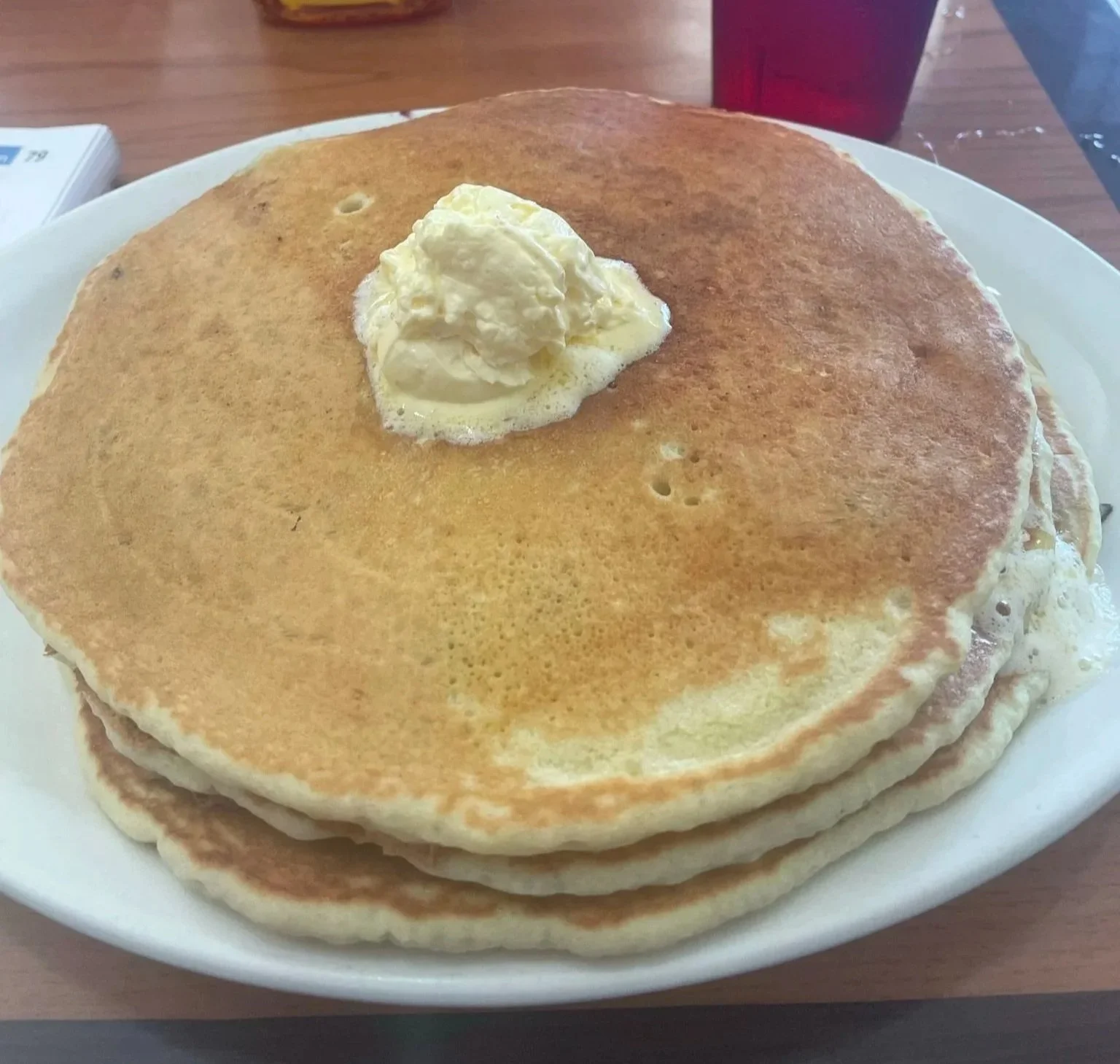Eat Like a Hobbit
If you had asked me how old I felt when I was planning my cross-country trek, I would have told you that my subjective age was at least twenty years younger than my biological age. I was 61 then, and I often heard folks state blithely and with false confidence, “Sixty is the new forty!” Possibly, yet there’s nothing like the endurance test of a long-distance bike trek to let your body know how old it really is.
One of the harsh facts of cross-country riding I was unprepared for was staying properly fueled. I expected I would deal with other punitive realities, such as wind, sun, climbs, and long days in the saddle, but I didn’t expect that I could never, ever eat enough.
My Garmin data show that I burned an average of 2,330 calories a day while pedaling. Keep in mind that a body at rest for a full 24 hours burns around 1,400-1,600 calories through basal metabolic functions, like cell repair, breathing and organ function. The day I met the Nez Perce prince I burned 3,479 calories -- just by spinning the cranks. Add to that the non-bike activity of a typical day – cooking, shopping, attending to Olympia (the motor home in which we slept most nights) – and I’m sure my body burned 5,000 calories a day, easily.
I started the journey with the headset of a much younger person. “I’ll just eat a lot,” was the working assumption of how to keep myself fueled. But that simplistic approach only worked when I had smooth skin and blond hair. As an older person, adequate nutrition was not just about the quantity of food; it was equally important to eat smartly and age-appropriately.
On Day 4, when we walked into our friends’ Emia and Mike’s place in Issaquah, Washington, Emia (a nutritionist by training), took one look at my depleted face, and scolded me. “No more of this eating healthy like you would at home. You’ve got to start taking in a lot more protein and sugars. This is about surviving!”
Wait? What? Surviving? This was supposed to be fun!
Day 44: Taking a coffee break in Lacon, Illinois.
So, I ate my way across the country. But three squares a day just wouldn’t do. Over time, I realized my meal cycle was more Hobbit-like than human (if you’re a Tolkien geek like me, you’ll know they eat seven meals a day). I wasn’t short like a Harfoot and didn’t have hairy feet, but I certainly ate like one:
Breakfast: I would usually start the day with a bowl of yogurt loaded with fruit or a bowl of Grape Nuts cereal and some fruit in cold water. (Cold water?” you probably ask. “Why not milk?” To which I reply, “Milk is for calves. And to be used judiciously when making cappuccino.”)
Second breakfast: After eating a fruity yogurt or bowl of cereal, I would prepare a cup of coffee and fry some eggs, mixed with chicken sausage. Only after the second breakfast would I be ready to start the day’s ride.
Elevenses: Hobbits have tea or coffee with biscuits for this 11 a.m. meal. If I could find a diner-like establishment on the road I would stop for an omelette, hash browns, and toast. If not, I would lower my standards and settle for gas station food such as a burrito or a grilled chicken sandwich. If I was riding with long stretches between towns, I made do with a Clif Bar or a mix of cashews, almonds, and raisins that I kept in my pannier.
Luncheon: I usually ate a couple of sandwiches (nut butter and honey) or leftovers of the previous night’s dinner (fish and rice; hamburgers).
Tea: Remember, tea in the UK is a meal as much as it is a drink. In the afternoon, I would try to find some coffee and gas station food (a piece of pizza or burrito). If no such “luck,” I would devour another Clif Bar. Or a package of salty toasted seaweed.
Dinner: Cooking in Olympia involved preparing a protein (fish, chicken, or burgers) with rice or quinoa, maybe mixed with lentils and coconut milk, or potatoes and green beans, and always a salad. If we ate out, well, there weren’t a lot of options in most small towns, but we were always game for Mexican food (where I would order beef or chicken enchiladas or maybe carne asada) or pizza. And occasionally moisten the hatch with a beer.
Supper: There were times when, still hungry only an hour after dinner, I would open the refrigerator and scrounge for any prepared salads or spreads I could easily devour. Or eat another portion of what we prepared for dinner.
Though not one of Tolkien’s six Hobbit meals, there was always dessert. Like the blue Jim Henson monster says, “Me like cookies.” I also spiked my water bottles with dissolvable Nuun hydration tablets to replenish lost electrolytes. On those cruel Illinois afternoons when it felt like I was riding across an open-road griddle with the heat index hitting 105, I made sure I took a swig of the sweet stuff every five minutes.
Fading
Despite the prodigious dining schedule and extra-large helpings, I hardly ever felt sated (well, there was that one time in an RV park restaurant in Arco, Idaho where I ordered an Elk burger with potatoes loaded with real bacon bits; I most certainly did not get up to scrounge the refrigerator that night). I felt more like our cat Tevye (aka, the four-legged stomach) who, after devouring his meals, always looks at me with an expression of disbelief that seems to communicate, “That’s all the food you gave me? I need more!”
I lost weight as I moved across the country and ended the trek ten pounds lighter. But more than a number on a scale, I realized that the effort was causing me to slowly fade as the energy supply never quite met the demand required to pedal all day. This fact, combined with the abusive heat in the northwest and the draining humidity once I crossed into Iowa, slowly debilitated me. And when I say “me” I really mean my body. Unlike my corporeal self, my mind was ever the perky, goal-oriented sonofabitch, sadistically punishing my corpus debile, having long ago cemented itself to the goal of riding across the country. As a result, not once did I dread getting on the bike in the morning, no matter how much I ached (early in the trek) or how weak I felt (later in the trek).
Day 51: A much diminished me munching on a Clif Bar on an Ohio trail.
Corn Syrup Blues
Another age-related discovery was that I needed to be more discerning about the empty calories I ingested. Twice, I unconsciously doused breakfast pancakes with syrup served with the meal. At home, I splurge and use Grade A maple syrup, but the amber, viscous liquid I poured over my flapjacks on those two occasions was predominantly composed of high fructose corn syrup. Soon afterwards both time I felt I had been drugged and could barely muster the energy to pedal. White rice and pasta didn’t ever seem to bother me, but given my age and the semi-distressed state of my body, those corn-based sweeteners almost did me in.
The stack of pancakes (before adding the syrup) that almost did me in.
When I was a young child, my old-world grandmother, true to the stereotype, would always be urging me to eat. I still can hear her voice, “Daglas, vy don’t you eat your Corn Flakes? Look at your cousin Alan. He et all ov his. You’re so skeeny – like a rooster! Eat!” As I crossed the country, I could still hear her words and I’d think to myself, “Sorry, Grandma. No matter how much I eat I still look skinny as a rooster.”



